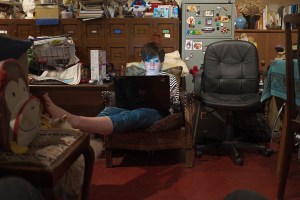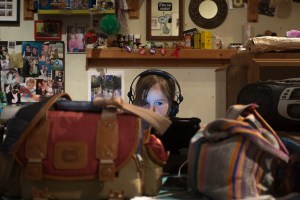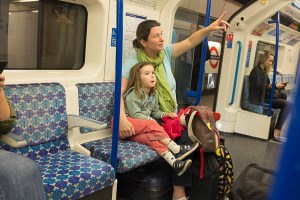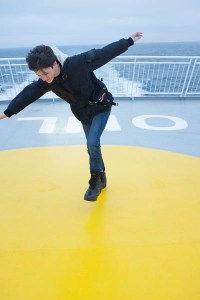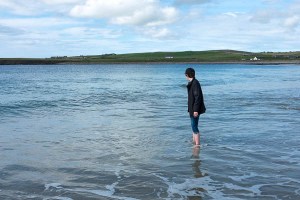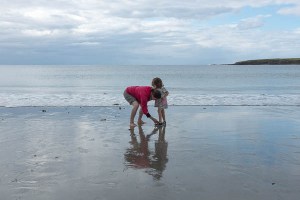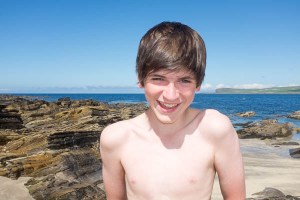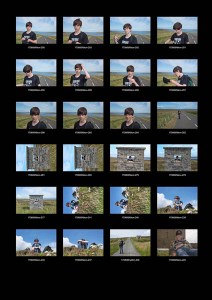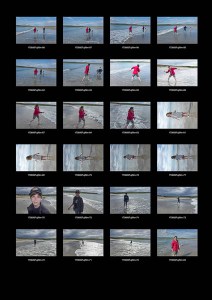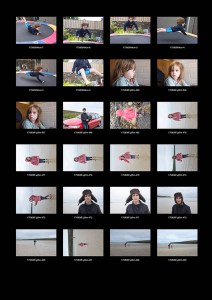What follows are some of the ways the research strands I have been following for the past couple of months have fed into my submission for assignment 2, Vice Versa.
Family Photography, Now (Book)
Sophie Howarth’s introductory essay – Is my family normal? (pp 6-13) looks firstly at what has usually comprised most people’s family photograph albums ( ‘the domestic photograph is still, largely, a tool for promotion’; ‘we organise our albums […] to tell the story we want to believe about our lives’; ‘the more unusual your family circumstances, the more important it seems to be to show yourself as “normal”‘) and backs it up with a photograph of Bashir al Assad (the Syrian president) and his wife and children from instagram and an apt quote from Martin Parr: ‘Most family albums are a form of propaganda, where the family looks perfect and everyone is smiling.’ This ties in neatly to the part of the course introduction which dealt with social media profile pictures (and albums of ‘day-to-day’ pictures) where most people seem desperate to show themselves in the best, and happiest, light.
She then goes on to offer an alternative to this, not ‘unhappy families’ but rather pictures which stretch the paradigm of what we show to others of our ‘private’ lives. These pictures, rather than replicating the pictures that everyone else takes, instead try to produce photographs that deal with the specifics of their own situation, highlighting how their family situation differs from everyone else’s. This work – which makes up the first half of the book, This is my life (photographers documenting their own families) – seems to be saying ‘My family is not normal and we’re ok with that.’
You have a single parent photographing his son until his son said stop (Robin Cracknell); Elena Brotherus trying to have an not get a family in Annonciation; Timothy Archibald working with his son to try to visualise autism; Cecilia Reynoso recording family gatherings in all their messiness; Colin Gray’s hugely constructed pictures his parents as they age; and more. All seem to involve the picture’s subjects and to depict something of the photographer’s subjective relationship to them.
The other thing that seems to unite all these depictions of family is that they have developed over time – 35 years in Gray’s case – allowing them to address changes in both individuals and in the relationships between them. This open-ended way of working (shared with Evan’s three years of covert photography on the NY subway or Germain’s eight years of picturing Charlie) is not something you can apply directly to a course with a set timeframe like this one.

1 – 2017

2 – 2017

3- 2016

4 – 2016

5 – 2014

6 -2014
For this assignment (and the aware project that led up to it) I have used photographs of my family taken during our annual holiday in Orkney. These pictures relate to those taken in previous years – locations and activities repeat; people get older; relationships shift – but for this assignment the pictures need to stand alone and to have been taken for it.
I hope I have been able to take the temperature of where we are – some family photographs, now. The assignment will add another growth ring to the photographic tree that is forming around holidays in Orkney, without being the whole tree…
Street & Studio and other Oppositions:
“Documents are documents because there’s this concept of the picture, and vice-a-versa…”
– Steve Edwards
In the opening lecture of the Street & Studio study day organised by Tate Modern, Steve Edwards describes a group of opposed concepts about ‘art’ and ‘not art’ that photographic theory has oscillated between during the nearly two hundred years the medium has been in existence. He starts the talk by quoting Jeff Wall saying there are two myths in photography – that photographs tell the truth and conversely that they do not – and ends with a second quote from Alan Sekula which suggests that the myth that photography does not tell the truth has replaced the myth that they do. Both quotes were apparently made around the same time (in the eighties); the talk was given a decade ago.
The definition of art needs ‘not art’ in order to make sense. ‘Not art’ implies the absense of a maker; it is literal, straightforward, a copy and not an original; it is therefore transparent. ‘Art’ results in pictures; ‘not art’ produces documents, traces of reality. In its early Fox-Talbot form, photography was not thought to be art. ‘Not art’ is not idealised (and so art is in pursuit of the ideal);’Not art’ is not made, it has no maker. ‘Art operates within a ‘high aesthetic mode’; ‘not art’ doesn’t operate, it just is…
Since its invention photography has oscillated between rejoicing in its status as ‘not art’ (‘the pencil of nature’, the emphasis on photojournalism in the 1930s, 40s and 50s) and disguising it through pursuit of pictures (in the 19th century, pictorialism; more recently through the constructed tableux of Crewdson and the other neo-Pictorialists). And somewhere between there is work which combines the picturing of ‘the real’ from the point of view of an artist (Walker Evan’s ‘documentary style’ or Jeff Wall’s pictures constructed to better ‘capture’ events than a straight street shot might).
The difference could in part be between ‘capturing’ and ‘making’ your pictures (or indeed, your photographs).
The pose and how to break it:
There is an essay (Eskilden; pp171-177) by Susanne Holschbach titled The Pose: It’s Troubles and Pleasures. It examines the way the idea of the ‘Pose’ is as different from the more neutral term ‘posture’ as ‘picture’ is from ‘document’ (or ‘fiction’ from ‘truth’ or indeed ‘studio’ from ‘street’).
Negatively – the pose’s artificiality allows someone to hide what is the truth about them (and this is what gives power to the paparatzi’s seeming ability to catch the famous with their mask off). Conversely, it can allow the photographer to impose their view of someone up them: the very action of taking a mugshot in a police station could be seen as defining the person pictured as criminal.
Positively – the pose allows people to project who they are and what they are striving to become; the pose and the objects and props associated with it allows people to define themselves (‘adapt[ing] their behaviour to resemble the image with which they identify themselves’) rather than having some one else impose an image upon them.
Holschbach also looks at the way photographers can try to undermine people’s tendencies to pose by distracting them from what they are actually doing – for example, in Phillip Halsman’s 1950s series of famous people, jumping – ‘having their photograph taken’ is displaced by ‘jumping in the air’. Their mask slips enough for us to get an idea of the person behind it. In theory at any rate.
Two Photographers:
1: Phillip-Lorca Dicorcia (b. 1951) – makes work that occupies a position straddling the divide between street and studio; Heads (2000) used hidden flash and a very long lens on the street to pick out individuals as they walked past; Hustlers ((1990-92 exhibited in Boston as Strangers in 1993) dropped sex-workers into prepared locations and photographed them with a large-format camera, creating a tension between what is ‘real’ (the model’s name, where they were approached to be photographed, how much they were paid) and what is constructed; the results of his work are not quite documentary and not quite posed, although they are definitely constructed.
2: Murdo McLeod (b. 1963) – Scottish editorial photographer working for the Guardian and the Observer; unlike most photographers working in newspapers, he has a distinctive style; this style involves non-naturalistic lighting and the use of props and goes well beyond what is ‘normal’ in newspaper photography; lighting often uses flash to increase the contrast between the subject and the outdoor background as night is falling; will work with subjects to get beyond their ‘photography face’ (Bobby Charlton in 2009 blowing out his cheeks and popping his eyes as if he might burst is a good example); makes you look and carry on looking.
Both DiCorcia and Macleod have created much of the ‘look’ of some of their pictures by using articifcial light in the form of strobes, operated outside. I do not possess powerful enough strobes to do this (and even if I did, I probably would not be able to justify lugging them up to the north of Scotland). However, there were possible ways to at least approximate the effect, making my subjects stand out against their background.
Lighting:
There is one of Harry Callahans’s Eleanor and Barbara photographs where they stand, side by side and facing the camera, lit by a diagonal shaft of bright light with a canyon of darkness forming triangles of black above to the left and below to the right. they are as ‘lit’ as if they were on a Hollywood sound stage. They are in the street, but the effect is definitely ‘studio’. The print had obviously been worked on to heighten the way the lighting had worked, but it had definitely been spotted, before Callahan put down his tripod, ‘There…’

project 2.1

exercise 2.2
There is lighting all around us. Sometimes we carry it with us; sometimes it is natural. It can be enhanced or altered with a judicious use of flash. It can sculpt someone’s face, or separate them from a background. If you put your subject into this ‘good’ light when you spot it or notice that someone or something is in a place where they are ‘lit’, it is a good tool to use when you want to move your pictures along the route from snap to portrait.

project 2.2
And the better you know a place, the more likely you are to know when this might to happen…
Constructing a picture to be read.
In my post on the portrait chapter of Bate’s Photography – The Key Concepts I have looked at both the 4 elements that comprise the readable content of a photographic portrait (face, pose, clothing, location) and the various psychological processes that are in play when we look at pictures of people.
Awareness of all this allows you to attempt a greater degree of control of how people may read your pictures. It may be impossible to translate everything that you feel about a scene or a person into something transmittable to others – there are associations I have with a lot of of the locations of my pictures that simply do not come across; the open door behind my sister in exercise 2.1 has a completely different meaning for her than for me – but if you can spot things that will ‘catch’ with others – the way a child stands on a beach can open up a path to identification of the picture’s subject with the viewer’s past self, say – you are more likely to make work that will arrest someone’s attention for longer than an unconsidered snapshot would.
If you can disguise this effort of construction in something that still retains some of the qualities of a snapshot, so much the better.
Reference:
- ed. Eskilden, U. (2008) Street & Studio – An Urban History of Photography London. Tate Publishing
- Edwards, S. (2008) Documents & Pictures. Session 1 of the event held at Tate Modern to examine the background to the exhibition Street & Studio (05/07/08)
Available online at: http://bit.ly/2xFuDAQ (accessed 02/09/17)
- Howarth, S. & McLaren, S (2016) Family Photography Now. London. Thames and Hudson.
- Macleod, M. (2010) Gnùis – Photographs by Murdo Macleod Stornoway, An Lanntair













